Letter to the Editor: Coronavirus Not Relevant to Needed Closure of Indian Point
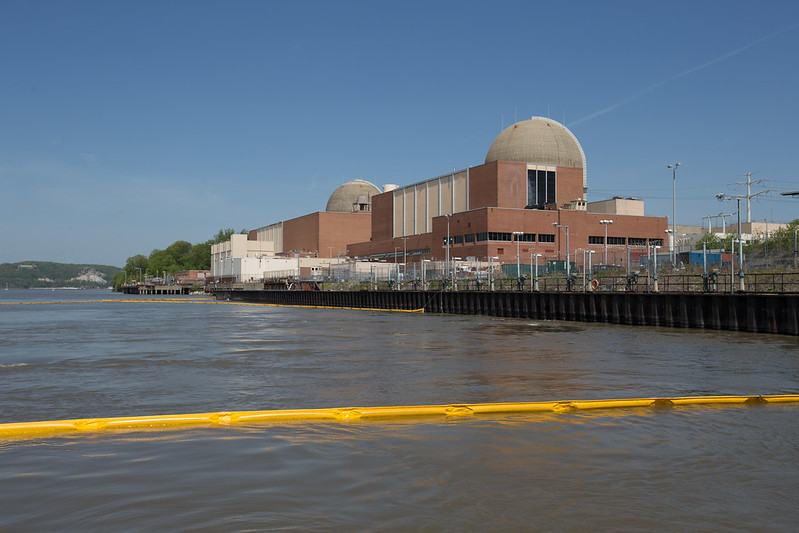
Indian Point nuclear power plant (photo: governor's office)
In an opinion piece published April 7, several pro-nuclear energy advocates opportunistically attempt to link the imminent closure of Indian Point 2 with the region’s response to COVID-19, warning of potential blackouts if it closes. This cynical fear-mongering is wholly devoid of any factual support, impractical, runs contrary to law, and is the opposite of what we need right now, which is solutions-oriented forward thinking.
First, far from threatening blackouts, the current crisis has actually driven power demand in New York City down by 12%. In addition, study after study shows there is plenty of power without Indian Point and the grid will be as reliable as ever. The latest study by PSE Healthy Energy confirms that even without any new gas plants reliability would not be an issue. The same study shows that since the closure was announced in 2017, the state has added enough renewable energy and energy efficiency to replace Indian Point 2. In short, we have a public health crisis, but we do not have an energy crisis.
Second, in practice, Indian Point 2 is already shutting down, as its fuel rods run out of juice —- power is down by 18% and you'd need 18 months' lead time to refuel it. In addition, Entergy has requested approval of state and federal regulators to transfer the plant to a different owner for decommissioning. Even if we were experiencing an energy crisis, which we are not, Indian Point would not be the solution.
Finally, the closure agreement only allows the state to extend the operation of the plant if there is an emergency “by reason of war, terrorism, a sudden increase in the demand for electric energy, or a sudden shortage of electric energy or of facilities for the generation or transmission of electric energy.” Since none of these conditions exist, the closure agreement requires the plant to cease operations.
Indian Point is a safety risk due to aging, potential for earthquakes, and the impossibility of evacuation in case of an accident. Its outdated once-through cooling system also kills billions of aquatic organisms every year damaging the ecology of the Hudson River. Indian Point’s closure will create a safer metro area poised for new, more sustainable sources of energy and conservation that will put thousands to work. It will also lead to recovery of the Hudson’s ecosystem once its destructive cooling system ceases operation. Right now, we should all be focused on protecting the health and safety of our fellow New Yorkers, not getting sidetracked by those seeking to use the current crisis as a pretext to call into question sensible forward thinking decisions made years ago.
Sincerely,
Richard Webster
Legal Program Director, Riverkeeper
@EnviroWeb, @Riverkeeper
***
Have an op-ed idea or submission for Gotham Gazette? Email This email address is being protected from spambots. You need JavaScript enabled to view it.
When Homeless New Yorkers are Safe, We’ll All Be Safer; The Mayor Must Use 30,000 Hotel Rooms Now

Homeless New Yorkers must be cared for amid the coronavirus (photo: mayor's office)
Last week we learned of Mayor de Blasio’s plan to move an additional 2,500 New Yorkers living in crowded shelters into hotel rooms by the end of April. While this may help some people escape the dangers of COVID-19, it simply does not meet the need.
For tens of thousands of homeless New Yorkers, virtually all of the protocols to prevent contracting and spreading coronavirus are impossible. Homeless people, by definition, cannot stay home, and many of the city’s 70,000-plus homeless people are living in settings that don’t allow them to easily wash their hands as frequently as needed or to shut a door and social distance from their neighbors.
If he really wants to make an impact, reduce the spread of coronavirus, and protect some of the city’s most vulnerable amid this crisis, Mayor de Blasio would utilize 30,000 of the 100,000-plus vacant hotel rooms across the city to move homeless New Yorkers out of the shelters and off the streets into spaces where they can easily practice social distancing, shower, use the bathroom, and wash their hands.
Further, the city already has a system and vendors for providing food to clients living in hotels, as it has long used commercial hotels as emergency shelters. And the mayor just announced enhanced efforts to deliver food to those who need it. The longer the mayor fails to act, the greater negative impact it will have on our whole city. Failing to act will lead to further spread of the virus and will continue to overwhelm the already overcrowded hospital system.
If homeless New Yorkers are safer, we are all safer!
Currently, over 19,000 homeless New Yorkers are living in congregate settings, where beds are often separated by less than six feet. Bathrooms and showers are shared by a large number of people. The food in the shelters is so notoriously awful that during the day, many people travel to soup kitchens or supermarkets to get nourishment. All of these factors lead to increased likelihood of contracting and spreading COVID-19.
Then, there are the thousands of New Yorkers who have stayed out of shelter due to the fear of violence within them and the knowledge of their own previous experiences with health and safety issues in shelter. Like their sheltered peers, they do not have access to personal protective equipment. With restaurants, recreation centers, and other public spaces closing their doors, unsheltered homeless New Yorkers have virtually nowhere to go to the bathroom, shower, or wash their hands. Some of our friends and neighbors have not showered since the city shut down.
On top of that, there is still the threat of NYPD “sweeps,” where people are only offered congregate, intake shelters as an alternative to moving from their spot. Despite CDC guidelines, the city continues to conduct such “sweeps,” which only serve to move people from place to place and make them even more vulnerable to contracting and spreading coronavirus.
Just as importantly, workers in shelters also face many of the same risks as shelter residents. The city has made lackluster efforts to provide personal protective equipment in the shelters, but it’s been made clear that homeless services staff and shelter residents are being left behind. Workers return home and are forced to put their families at risk, too.
As of April 15, the Department of Homeless Services is tracking 487 homeless New Yorkers who are positive with coronavirus, including 22 living in the streets; 131 shelters have had positive cases and 33 homeless New Yorkers have passed away. We estimate that the true scope of the damage is much higher, but the data is lower due to undertesting.
We need 30,000 single hotel rooms now and the mayor has the resources to do it. Other cities and states are using federal emergency funding to make happen.
Mayor de Blasio has already made significant missteps in his efforts to combat coronavirus, including delays. He has waited far too long to help the homeless, and by doing so, he is putting homeless people, the staff that work with them, and all New Yorkers who come into contact with them at risk.
He must act immediately to prevent further tragedy.
Finally, after this is all over, there is no going back to normal. During this crisis, we are seeing the human toll we caused by managing homelessness rather than ending it. Moving forward, every possible resource should be used to move people out of the hotel rooms into their own apartments rather than back to the shelters. That means, among other important steps, strengthening the CityFHEPS voucher by increasing it to fair market rate so people can actually find apartments on the market, utilizing all vacant supportive housing units for those eligible, and placing people into set-aside housing units for those leaving homelessness.
The city must put forth an urgent plan for housing homeless New Yorkers, now and into the future. As a city, we made the mistake of accepting homelessness as an everyday reality. We can never make that mistake again.
***
Peter Malvan is currently homeless. He is a Safety Net Activist, the Co-Chair of the Persons with Lived Experience Committee of the NYC Continuum of Care, and the Vice President of the Midnight Run. Josh Dean is the Executive Director of Human.nyc, an advocacy organization focusing on street homelessness.
***
Have an op-ed idea or submission for Gotham Gazette? Email This email address is being protected from spambots. You need JavaScript enabled to view it.
Lessons from the Pandemic: Coronavirus Crashes a New York City History Course
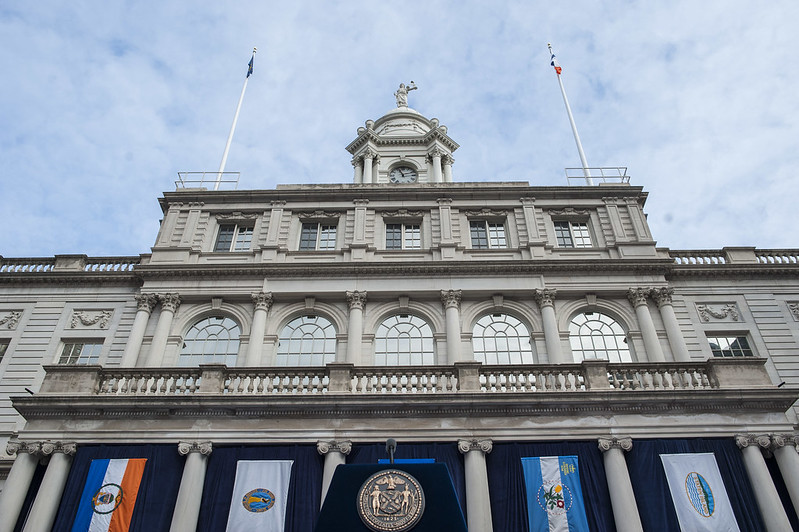
City Hall (photo: Mayor's Office)
I usually start each session of my graduate seminar on the city with a question: “So did anything significant happen this past week that we should discuss?” This time, as I looked at 18 faces across a computer screen for the first time, it evoked a gasp.
My students and I won’t sit in a room together again as we did for weeks before, but we will continue to learn with and from each other. I think, teach, and write about New York. They are New York: diverse, smart, ambitious, striving to do better for themselves and for others. They are losing income; they are struggling to maintain some degree of normalcy. A few have done the unthinkable and moved back with their parents to gain space.
The course is a deep dive into the history and politics of New York, organized around the tenure of mayors from La Guardia through de Blasio. Little did I know when I conceived it that de Blasio’s reign might mark the end of New York as we knew it. We still don’t know what that means. Can we draw anything from the past to help us anticipate what lies ahead? If history does not provide us with answers, perhaps it can help ask the right questions.
I never liked the idea of remote learning. I saw it as a cost-cutting technique that would cheapen the educational experience. I still do. Now with no other choice, I have to admit that it enforces a sense of intimacy I had not expected. Now my students are in my home and I’m in theirs. Should I offer them a glass of wine or a wedge of cheese? We seem somehow closer, drawn together by the madness around us outside the safe space of the computer screen. We are in it together.
What can we learn? We had just completed a lesson on the city fiscal crisis of 1975. The vulnerabilities of the local economy exposed then are on display now as theaters and restaurants close, people are furloughed, the tourist industry has tanked, and Wall Street is in a panic. What exactly will the budget cuts look like? Who will suffer?
Last time it hurt those who need city services the most. We had seen how the 1975 crisis magnified the state’s power over the city as our current governor distinguished himself and moved to the center of the national stage. Even those wary of his governing style had to concede a hint of admiration. He was now the good bully who could stand up to the Twitter monster of Washington. Yet, a glimpse of his usual self was apparent when he and the Legislature buried an election law provision in the crisis budget that would make it more difficult for his Working Families Party opponents to get their progressive candidates on the ballot.
Our class already had covered the topic of suburbanization. Reading Ken Jackson’s history of how privileged 19th century families once built country homes to escape plague-ridden cities seemed quaint a few weeks earlier. Now it is suddenly relevant. Would the new pandemic serve as an equalizer between the rich and the poor? No, not a chance. Not in a city and country more economically polarized than ever. The poor and people of color are dying in larger numbers.
Will the coronavirus restructure the economy of New York? Clever corporate executives who need to recoup losses don’t need much imagination to see the experience as an experiment in remote labor that could cut the costs of Manhattan office space. What will be the long-term effect on commercial real estate if working at home becomes more common? If employees don’t regularly commute and set up shop in their living rooms instead, will they start to rethink life in those cramped city apartments? Will they respond more appreciatively to the beckoning call of open spaces in the outer reaches? What if flight from the city drives down the cost of residential real estate in the boroughs? Could that slow an outward migration?
Of course, the big question in our seminar is one I always thought I had the answer to. What is this creature we know as New York? Does it have a soul? If so, is it a kind and loving soul that takes care of the disadvantaged and the marginalized? Or is New York a harsh master that drives vulnerable people further into the ground? We examined the pre- and post-fiscal crisis city -- or should I say cities -- as a way to approach the question.
The former was a city of hope and promise that took us through the Great Depression and became a battleground for equality during the sixties. The other was a city obsessed with its own economic survival, retreating from its ambitious social agenda. As New York struggled through the latter more sobering chapter of its recent history, we observed how gentrification evolved: once sought as a source of fiscal regeneration, now understood as a byproduct of economic polarization.
Studying the past, we are reminded that New York was best-equipped to propel its progressive dreams when it had an enabling partner in Washington, D.C., epitomized by the leadership of Franklin Roosevelt and Lyndon Johnson. More recently, with a White House devoid of capable or caring leadership, local leaders had convinced themselves that the next round of New York progressivism could be a bootstrap effort paid for by the proceeds of its own miraculous recovery. Today that recovery is at risk.
What will the future bring? It is too early in this bleak episode to say. For now, we can just keep educating ourselves and try to ask the right questions.
***
Joseph P. Viteritti is the Thomas Hunter Professor of Public Policy at Hunter College and author of The Pragmatist: Bill de Blasio’s Quest to Save the Soul of New York (Oxford).
***
Have an op-ed idea or submission for Gotham Gazette? Email This email address is being protected from spambots. You need JavaScript enabled to view it.
State Budget Includes Extensive Cutbacks But We Don’t Know What They Are Yet

Governor Cuomo gives a budget presentation (photo: Kevin P. Coughlin/Governor's Office)
New York State and City are the gruesome public health epicenter of COVID-19, with horrific daily death tolls. The coronavirus is likely causing New York to also be the economic epicenter of the nation’s staggering job and economic loss, although those are statistics that will play catch up.
New York State’s fiscal year is April 1 to the following March 31, so the Governor and the Legislature just adopted a new budget (slightly late on April 3), just weeks after the national shutdown in mid-March, leaving little time to determine how the virus would affect the state’s economy and tax revenue. Several federal bailout bills were passed before New York adopted its budget, but Governor Cuomo bitterly complained New York was badly shortchanged in those bills and was among those calling for a fourth such package with significant aid to states and localities.
The National Governors Association (Gov. Cuomo is the Vice-Chair) just asked Congress for another $500 billion for state governments alone, not even including local governments.
The adopted New York state budget recognized revenues would plunge with the declining economy, and set targeted painful spending reductions without specifying exactly what they would be. The Budget Director is supposed to establish a plan for the spending reductions. The State Legislature authorized the creation of processes for remote voting even as it passed the budget two weeks ago, so that it could continue to make decisions without returning to Albany. But where the budget is headed is still uncertain; what’s really needed is another federal bailout package.
The state budget authorized a reduction of $10 billion, or about 10%, from what had been the initially submitted Financial Plan for $105.8 billion in state operating funds, the core of the budget funded with state dollars. The spending reduction will bring State Operating Funds to $95.8 billion. Some parts of the budget were exempted from cuts, meaning other parts might have to take cuts larger than 10%.
Below is a table showing how that $105.8 billion was proposed in January to be distributed, in the column FY 2021 PROPOSED. The Financial Plan to be released after budget adoption has not yet been published, but the spending parameters will be similar to what was submitted. The $10 billion cut will have to be taken from the programs in that column.
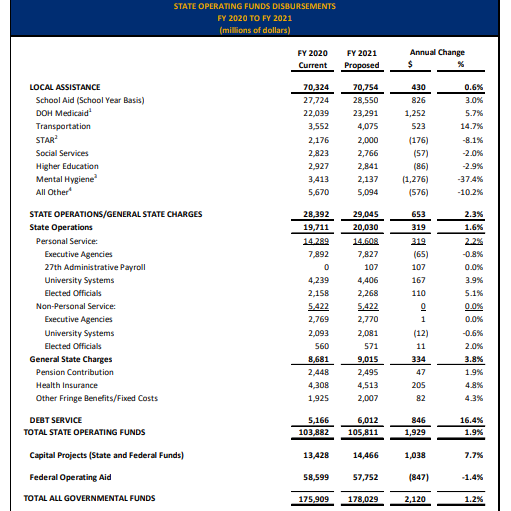
The State law directing the $10 billion reduction prohibits cuts to public assistance benefits and income supplements for the aged and disabled. It also prohibits cuts to debt service, contractual obligations, and spending pursuant to court orders or judgments. That means pensions and health insurance for state employees and retirees could likely also be exempt from cuts in the short-term, in addition to debt service and public assistance.
Spending in other vital areas, like pre-K to 12 education, higher education, Medicaid, social services like child care and child welfare, public safety, or transportation, could take the brunt of the cuts, to the extent funding is not backfilled by what has already passed Congress.
The $10 billion cut, however, is potentially just the first reduction. The budget permits the Director of the Budget to reduce spending again at three intervals over the course of the year, depending on how much revenue is coming into the State Treasury. The Legislature must receive ten days notice before any new cuts, and has that time to override them, by concurrent resolution of both houses. The new remote voting procedures would enable the Legislature to do that without returning to Albany. Robert Mujica, the budget director, estimated revenue losses could reach $ 15 billion, but nobody knows right now. If the economy declines further than the initial estimate, cuts could be even more severe.
Implementation Lacks Transparency, Budget Plan Should Be Disclosed Says Citizens Budget Commission
Critical decisions include how the federal bailout funds are used, what gaps remain after federal funds are used, and what the choices for cutting will be where there is no federal relief. There also probably won’t be one set of decisions, but many over a number of months.
Congress has already passed several bailout bills, which have included estimates of about $1.1 billion for education for New York and Medicaid spending relief estimated at $4.5 billion. A general state and local relief package included $7.5 billion for New York State, but the state government must share those funds with local governments and the share reserved for the state government itself was estimated at $3.1 billion. Separate appropriations for hospitals were also included in the federal bailout. But it’s clear these federal funds won’t make up for New York’s adopted cutbacks, let alone any new ones.
Below are several critical aspects of the state budget framework:
New York Medicaid Cuts Partially Adopted, But Postponed to Access Federal $
Governor Cuomo had set up a Medicaid Redesign Team at the beginning of the budget process to ratchet down exploding Medicaid spending, and on March 19 the team recommended $1.6 billion in cuts to and savings from the program. But the federal Medicaid relief package prohibited states from using the funds while cutting their Medicaid programs. The enacted state budget permitted the Division of the Budget to delay implementation of the Medicaid cuts to take advantage of the federal funds. But the federal financing expires in a year; right now the cuts would go forward next year, absent further changes.
Tax Filing Deadline Postponement Hurts New York Cash Flow; Budget Allows $8 Billion in Borrowing and $3 Billion Line of Credit
In April 2019, according to New York State Comptroller monthly cash reports, New York ran more than a $6 billion surplus in its State Operating accounts, primarily due to the April filing of New Yorkers’ tax returns. But New York will not have that luxury now. Federal and State tax return filing deadlines have been delayed from April 15 until July 15, putting New York’s cash flow into a precarious condition and delaying critical information on revenue to the state’s leadership.
The economy’s downward plunge cannot be tracked with normal tools. A decision to borrow up to $11 billion is mind-boggling, but essential to avoid a collapse of New York’s government and a good decision. The budget permits the short-term borrowing to be extended next year, or even converted into a long-term borrowing, which would be tantamount to borrowing to pay for operating expenses, a bad practice but we are in an emergency and interest rates are very low.
What’s Missing? Public Disclosure in Real Time
The state budget over the next several months will undoubtedly be a series of halting and difficult steps with no easy decisions. But the public deserves a regular process of disclosure of what choices are being made step by step. That includes state cuts, federal backfills, and state borrowing.
The adopted Financial Plan is not yet even public, and normally there would be a 1st quarter update released sometime after June 30 (the end of the 1st quarter). Last year the 1st quarter update was not released by the Division of the Budget until August. But now critical decisions will be ongoing within a few weeks and continue for months. The Governor and the Division of the Budget have an obligation to disclose such vital information in real time, not after the fact. If the situation improves and cuts can be restored, that will be good news.
***
Jim Brennan was a member of the New York State Assembly for 32 years, where he chaired four committees. On Twitter @JimBrennanNY.
***
Have an op-ed idea or submission for Gotham Gazette? Email This email address is being protected from spambots. You need JavaScript enabled to view it.
Fighting Climate Change and Offering Good Green Jobs: New York City Must Save Its Recycling and Organics Composting Programs
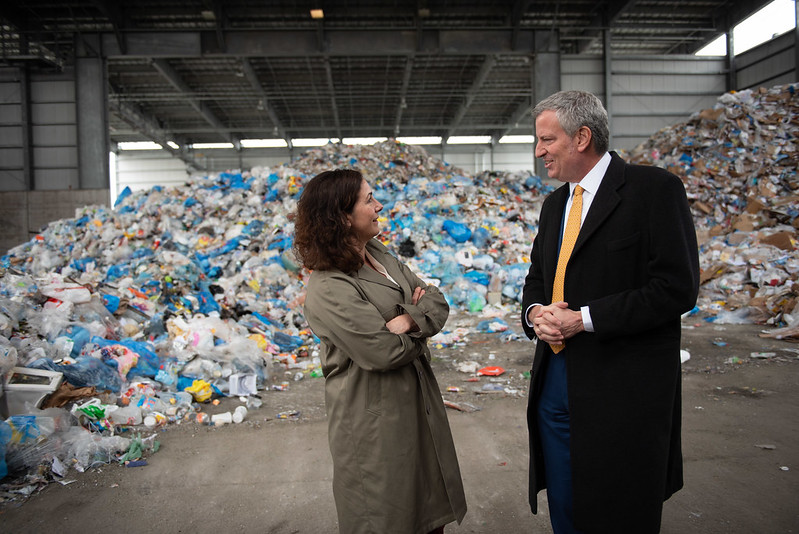
Mayor de Blasio at a garbage facility (photo: Michael Appleton/Mayor's Office)
Even as the global COVID-19 shutdown produces fortuitous environmental benefits such as cleaner air due to a huge decline in travel, the U.S. Environmental Protection Agency is cynically using the pandemic to justify backtracking on pollution standards and enforcement, easing a path for climate change and related catastrophes to continue unabated. This is deeply concerning. By some measures, last winter was the warmest ever recorded, and the 2020 hurricane season is expected to be more active and dangerous than normal.
Sustainable waste management remains one of the vital environmental policy areas in which municipal and state governments retain full control. As New York City enters a budget process filled with painful choices, the mayor should rethink the hasty decision to suspend compost collections, and should preserve the Department of Sanitation’s (DSNY) organic waste recycling programs. These are critical local climate change initiatives that also provide good, green jobs our communities will desperately need during this recession.
Food scraps, food-soiled paper, and yard waste comprise more than one-third of what New Yorkers throw out, and residential food waste will likely increase as more people eat at home during the emergency. When buried in landfills, as most of this material is, these organic materials emit methane, a greenhouse gas about 30 times more potent than carbon dioxide. Modern organics composting and recycling facilities can transform food scraps and other organic waste into a nutrient-rich soil or fertilizer and renewable energy sources – but only if we sort and collect organic waste separately from other recyclables and trash. Without continuing and expanding our organics recycling capacity, we won’t be able to move the needle on this major greenhouse gas source anytime soon.
Composting and recycling waste also create and sustain far more jobs than exporting garbage to landfills and incinerators. Although relatively small, New York City’s organics programs already employ more than 100 uniformed sanitation workers in collections alone, in unionized jobs where safety, training, and benefits are available. Dozens more workers are employed at food scrap drop-off sites, local composting facilities, and in other green jobs. Rather than hastily axing these positions, we should view sustainable waste management as a green jobs pipeline at a time when New Yorkers are struggling more than ever.
While recycling is often an easy target for cash-strapped local governments facing a grim fiscal picture, recycling programs cannot simply be switched back on after the economy recovers. Temporary suspension of activities that place our heroic sanitation workers at any additional risk of infection may be necessary, but the cuts to compost collection appear more long-term. Successful diversion programs require widespread public participation, years of ongoing education, and behavior changes by millions of individuals and businesses. Note that the city has only just started to approach the recycling levels achieved two decades ago before Mayor Bloomberg suspended metal, glass and plastic recycling in the aftermath of 9/11.
New data suggest that New Yorkers want to keep composting and recycling during this crisis. In March and the first week of April, residential compost collections continued unabated in the communities where the program is well-established, and New Yorkers separated more food scraps in their brown compost bins this March than they did in March 2019.
Other cities, including San Francisco and Seattle, have continued to treat compost collection as an essential service, despite implementing some of the strictest stay-home orders in the nation. Early reports suggest residents and businesses continue to diligently separate food scraps, yard waste, and other recyclable materials.
We know our leaders care about recycling too. In recent years, the Sanitation Department, the City Council, and the Mayor’s Office have taken critical steps to expand and normalize organic waste recycling. By last year, Sanitation was collecting and recycling about 250 tons of organic material per day. The city is also poised to require and incentivize greater participation in food waste recycling by businesses, using a new commercial waste zones system. Several elected officials have emerged as champions of organics recycling and sustainable waste management, including City Council Member Antonio Reynoso, who chairs the Council sanitation committee, and Speaker Corey Johnson, both of whom fought to pass the landmark commercial waste zones bill and have called for citywide, mandatory food scrap recycling.
These programs should be seen as essential services, cornerstones of our climate mitigation strategy, and a source of good jobs for communities that will desperately need them. New York City must prioritize our recycling and organics composting programs.
***
Justin Wood is Director of Organizing and Strategic Research at New York Lawyers for the Public Interest. On Twitter @NYLPI.
***
Have an op-ed idea or submission for Gotham Gazette? Email This email address is being protected from spambots. You need JavaScript enabled to view it.
Coronavirus Widens Digital Divide, But Creates Opportunity to Finally Bring All Into 21st Century
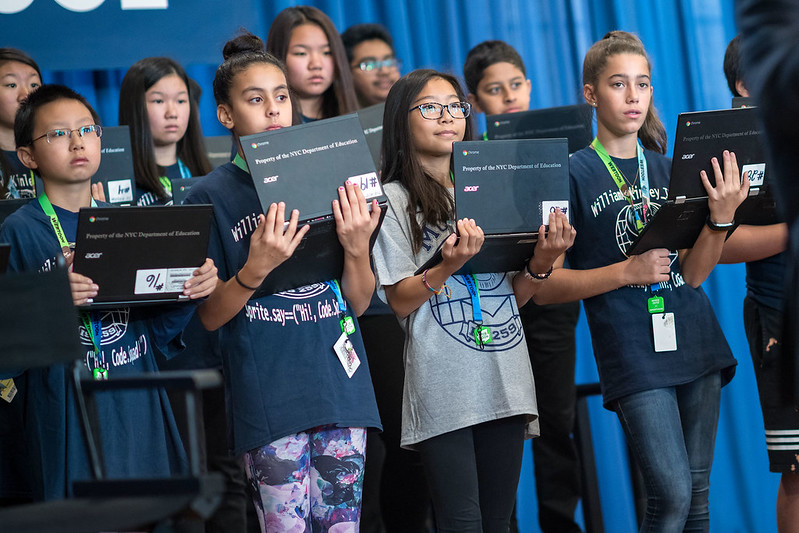
Students and laptops, eyeing the digital divide (photo: Ed Reed/Mayoral Photography Office)
Among the many lessons the coronavirus outbreak is teaching us about our society is that we are not prepared to live in the 21st century, particularly residents in low-income communities with little or no access to much-needed technology.
This century is a time of continued uncertainty, in which established norms change overnight and disruptions are being regularly caused by natural and man-made disasters. Our largely interconnected globe means that the spread of information, goods, and diseases can occur with lightning speed.
We’re in the midst of another technological revolution that is dramatically changing how people shop, communicate, work, and learn.
But even before the coronavirus pandemic, not everyone had been part of the changes that have been occurring in the 21st Century. And those discrepancies have come into full relief, and been exacerbated, as COVID-19 has led to school and workplace closures.
Consider the implications of the “stay at home” orders requiring K-12 schools, colleges, and universities to move education from in-person to remote, online learning.
Many educators are ill-prepared to teach online; many students are unable to connect for their online classes. In New York City, a million households lack access to the Internet and, if they have a connection, it is often at speeds too slow for effective online education. Nearly 300,000 students in the New York City public schools have no computer or tablet of their own to access the Internet. In an age where companies have enormous amounts of data on individuals, the New York City Department of Education had no idea which students have access to the Internet or own a computer or tablet -- the city is now promising all who need them will have them seven weeks after school buildings were closed due to the pandemic. How can the DOE plan for a crisis without this kind of imperative data? The same can be said about the challenges faced by public colleges and universities.
The Center for an Urban Future recently reported the tech sector in New York City has been expanding faster than the number of available skilled personnel to fill the jobs. To qualify for these high-paying jobs requires education and the development of special skills – such as critical thinking, complex problem solving, teamwork, and the ability to work under uncertain conditions. The report further identified the underrepresentation of youth from low-income communities in the tech sector. The move to online education, however long it may last, reinforces the gaps for low-income communities, and shines a bright spotlight on the fact that students’ lack of access to the Internet and the equipment needed to access it are key reasons why these same young people can’t acquire the skills and knowledge needed for the 21st Century economy.
For all practical purposes, we have a system accessible only to those who can pay for access. In the 21st century, everyone needs access to a computer or tablet and connectivity to the Internet to make their way in life. For most, the only option is paying a private provider – this is not a viable option for many low-income families.
It is time to stop thinking of the Internet as a private good available only to those who can pay. Instead, the Internet needs to be viewed as a public good accessible to all, independent of ability to pay. As a public good access to the internet has to be extended to all households, independent of their ability to pay. Efforts in New York to accomplish this through charter agreements with cable companies have proven ineffective. The enormous federal funding allocated to address the many issues raised by the coronavirus pandemic provides opportunity for achieving an essential goal: completing the nation’s “Information Highway,” or Internet network. Speaker Nancy Pelosi has indicated the House of Representatives is considering such an effort in a new infrastructure bill. Once the internet is available throughout the U.S., providers need to develop service plans that provide low-income communities, whether urban or rural, access to basic services at an affordable cost.
Life is not going to return to the way it was before the coronavirus. More people will work, learn, shop, and play using varied online tools, and more remotely than ever.
Bringing all Americans into the information age will require a momentous effort on the scale of the federal project that brought electricity to darkened regions of the country during the New Deal. The coronavirus has made it clear that completing the Information Highway, making it accessible to all, independent of ability to pay, is critical to the national interest and addressing the social injustice caused by the digital divide.
***
Stan Altman is President, Science and Arts Engagement New York, Inc; Professor, Marxe School of Public and International Affairs, Baruch College; and Visiting Professor, The City College of New York.
***
Have an op-ed idea or submission for Gotham Gazette? Email This email address is being protected from spambots. You need JavaScript enabled to view it.
The Coronavirus Crisis Must Open Our Eyes to the Flaws of the New New York
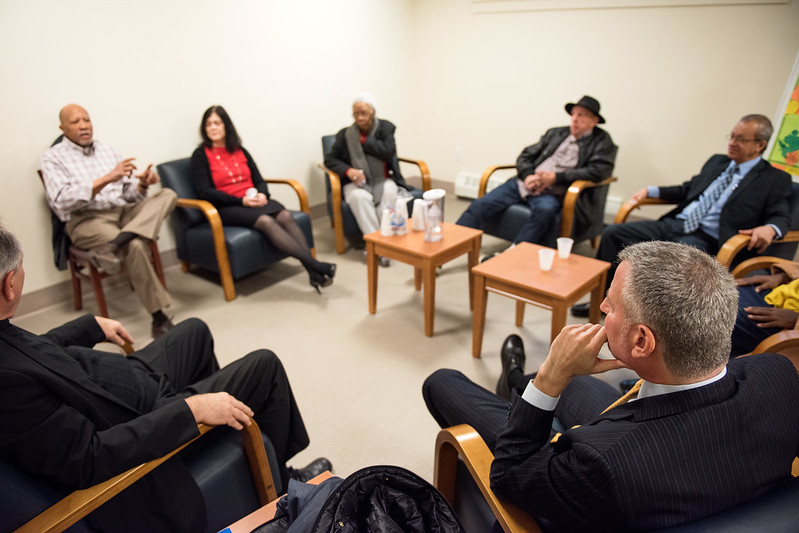
Mayor de Blasio at a supportive housing site (photo: Demetrius Freeman/Mayor's Office)
As our great city faces its most challenging crisis in the past 100 years, it has revealed to all of us how the city has radically changed in the past few decades.
The virus has now put a spotlight on the critical shortage of hospital beds and medical equipment like ventilators. In fact New York City ICU bed capacity ranks in the bottom quarter nationally. If you have lived in the city for over 40 years, as I have, you likely recall how many hospitals have closed and not been replaced.
But the current crisis also shows other deficiencies of the new New York of the past decade or so, even with all its wealth and abundance. These limits to the social fabric must be addressed as we look toward a rejuvenated post-coronavirus New York City.
I vividly remember visiting my assistant’s son as he and many other young men were suffering from the scourge of AIDS at St. Vincent's Hospital in Greenwich Village. This once-great medical center is now home to luxury condominiums, a conversion emblematic of troubling trends we’ve seen in our city. I can’t help but think of St. Vincent’s today as our hospitals overflow with coronavirus patients and we build pop-up facilities in parks and convention centers, while welcoming a Navy hospital ship to the Hudson.
We must place a total moratorium on the closure of hospitals in New York City, even if it means massive government support for these institutions whose importance has become even more evident during this crisis.
As our city has seen its population surge to 8.5 million and the yearly total of tourists climb to over 60 million a year, we’ve seen a city more crowded than ever. The subways were moving 4 million people a day in overcrowded trains, which was probably a factor in the spread of this virus. Experts say keep six feet away from another person to ensure some degree of safety, but many times the person next to us on our train is just 6 inches away, if that!
The surge in population over the past two decades based on foreign and domestic migration to the city, following in the grand tradition of New York as a place of opportunity and refuge, has contributed to a severe shortage of housing and record homelessness. There are now 58,000 men, women, and children living in our main city shelter system at a cost of $2 billion a year, with thousands of others in various other shelter accommodations. There are also roughly 3,500 homeless people sleeping on our streets and subways. The city is reporting a growing number of positive COVID-19 diagnoses in the shelter system and on the street, and some homeless people have already died after contracting the virus.
This scourge should once again put the spotlight on the need for low-income housing and, more importantly, supportive housing for those that are deeply afflicted by mental illness and drug addiction. And it should lead to a massive effort toward bringing many thousands of both types of housing online as quickly as possible.
In addition, the city’s public housing system, home to more than 400,000 tenants, is on the verge of collapse, and is also being rattled by the toll of the coronavirus. The city must take measures to safeguard NYCHA tenants, and must not now allow this very valuable resource to disappear as it has the hospitals. A NYCHA rescue plan must move ahead at full speed.
We also have a severe shortage of psychiatric beds to serve the most seriously mentally ill, including some of those individuals residing in shelters and sleeping on the streets and subways. There’s been a 15% decline in these beds in the past few years, continuing a longer-term trend. We must declare an immediate freeze on the closure of such facilities. The noble experiment, started 40 years ago, to release mentally ill patients from institutions and into the community has not been a total success and we need to admit that and increase, not decrease, the number of inpatient beds and outpatient treatment centers.
Our city is not only the epicenter of the virus in this country it is also the epicenter of income inequality, with 40% of the population living at or near the poverty level. We cannot continue to allow the destruction of moderately-priced apartments, such as I often see on the Upper East Side, where several floors of modest apartments, existing above a retail store, are torn down to make way for luxury housing. The city must declare a moratorium on this type of development. In addition, taxes must be increased on luxury apartments and their residents so that the city can meet the needs of those in need.
I am a proud New Yorker who has lived here all my life, and I am not giving up on our city, and I am confident we will rebound, but this horrible virus should open our eyes to the need to make changes to ensure our city is a great one for all in the future. Next year we will be electing a new mayor, and we must insist on that person being a visionary with important new ideas and not a custodian of the status quo
***
Robert Mascali is a former Deputy Commissioner at the New York City Department of Homeless Services and a former Vice President for Supportive Housing at Women in Need.
***
Have an op-ed idea or submission for Gotham Gazette? Email This email address is being protected from spambots. You need JavaScript enabled to view it.
Surveillance and The City: A New York Dictatorship?
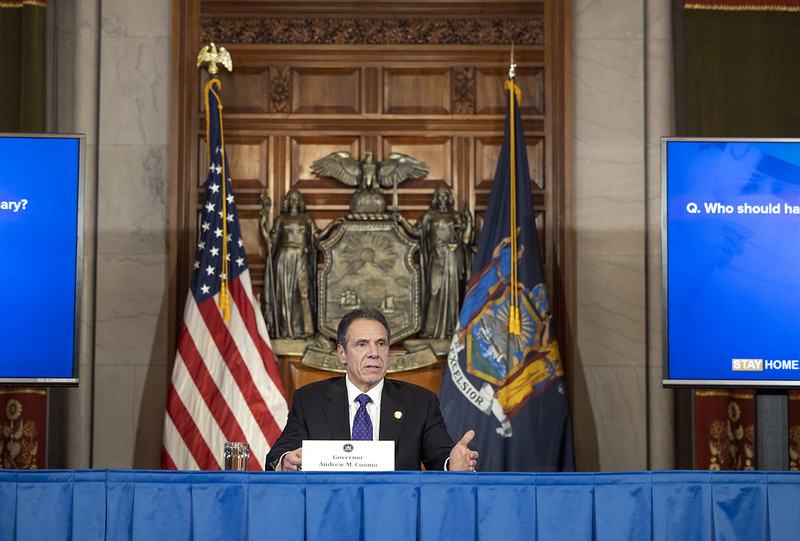
Gov. Cuomo at one of his coronavirus briefings (photo: Mike Groll/Governor's Office)
The consequences of poor social distancing, inadequate supply chains, and nearly every other facet of our COVID-19 calamity are nothing short of life and death. But as New York endures a disaster unlike any in our lifetimes, as we see our morgues filled and our store shelves stripped bare, this teeming tidal wave of death might upend most fundamental assumptions about our way of life.
We are about to face a deeply dangerous moment, not just because of COVID-19, but because of the extreme measures we use to stop it. As the weight of a previously unimaginable magnitude of human suffering turns the bedrock of civil society to quicksand, we run the risk that our core institutions might buckle and that we will undermine the rule of law as we know it.
If one looks for an American precedent for the extraordinary powers granted Governor Andrew Cuomo in this crisis, one will come up short. Whether you look at past pandemics or times of war, never before has our state entrusted one man with so much control over so many, with so few safeguards. Our courts are shuttered, our legislators are struggling to meet, and more and more reliance is placed in the executive branch. Since March 7, more than a dozen executive orders have modified everything from licensure requirements for funeral directors, to medical malpractice liability, to environmental protection laws, and even our election timelines.
No, there is no precedent in American history for this type of emergency action, but there are ancient parallels to a society where, “in times of plague,” a leader would be given extraordinary powers: the Roman Republic.
Long before the virtues of the Republic’s rule gave way to the tyranny of imperial Caesars, the Roman Senate saw the appointment of temporary “dictatores” as an emergency measure to counter existential threats, or as we would call them today “dictators.” Many will recoil at the use of the term “dictator,” with its modern-day connotations. The word may be centuries old, but it’s typically associated with modern-day war criminals — men marked by their violence and human rights violations. The dictators of Rome were a different creature, a single official granted extraordinary powers, but subject to one overriding restriction: temporary rule.
Unlike the dictators of today, whose tenure is often marked by permanent power, the dictators of Rome were a short-lived ‘necessary evil,’ citizens of the republic granted singular control for six months and no more. They were a walking contradiction, men given unilateral control to safeguard a society whose overarching aim was to prevent the consolidation of power. Their role was to suspend republicanism for a short time to safeguard it for the longer-term.
A “Dictator’s authority was bounded only by the requirement that he fulfill his task or lay down his power within a set time, and the requirement that he not change the constitution,” wrote Nomi Claire Lazar in “States of Emergency in Liberal Democracies.” As I explained in last-month’s column, Governor Cuomo’s new emergency power has only two limits: he cannot change the Constitution, and his powers expire next year. Until that time, Cuomo can repeal or enact any law that he declares is needed to respond to COVID-19, any law, so long as he doesn’t violate the Constitution. And he hasn’t let that power go idle, introducing a new executive order (on average) every other day.
At a time when Cuomo has unprecedented popularity, when many of his emergency actions are saving lives, I know how few will care about “legal niceties” of checks and balances. But if we continue to rewrite the rules that have governed New York State since 1777, we have to be crystal clear about how we prevent these changes from undermining the values that are central to an open and democratic society.
It’s hard to imagine how New York’s founders, the men and women who wrote lengthy treatises on the need to “expel civil tyranny” might respond to a governor so empowered and emboldened as the one we have now. They too were students of history and knew well that those granted extraordinary powers to face extraordinary threats are rarely willing to part with them.
The sad truth is that there is no one right answer on what to do. If we blind ourselves to the crisis and fetishize the separation of powers, it will only slow our response and cost lives. But if we simply empower the executive and call for his actions, we create truly unprecedented dangers to democracy. A single man, free to act without approval or oversight, will make mistakes. Competing viewpoints are not merely a philosophical luxury, they are key to navigating complex decisions. This is why the legislature must keep a close eye on Cuomo’s actions, reasserting its authority and overriding his decrees when needed.
The reason New York kept checks on the powers of governors, even in times of crisis, for nearly 250 years is because we know that human beings are fallible. We know they will make mistakes. And we know that left to their own devices, they will wield power to their own ends. Let’s just hope that we follow the example of those earlier Romans and insist that no matter how grave this pandemic becomes, that we make sure the dictator yields his powers after a brief time, even if the threat remains.
***
Albert Fox Cahn is the founder and executive director of The Surveillance Technology Oversight Project (S.T.O.P.) at the Urban Justice Center, a New York-based civil rights and privacy group and a fellow at the Engelberg Center for Innovation Law & Policy at N.Y.U. School of Law. He writes the monthly Surveillance and the City column at Gotham Gazette. On Twitter @FoxCahn & @STOPSpyingNY.
***
Have an op-ed idea or submission for Gotham Gazette? Email This email address is being protected from spambots. You need JavaScript enabled to view it.
Coronavirus Tests New York City Schools
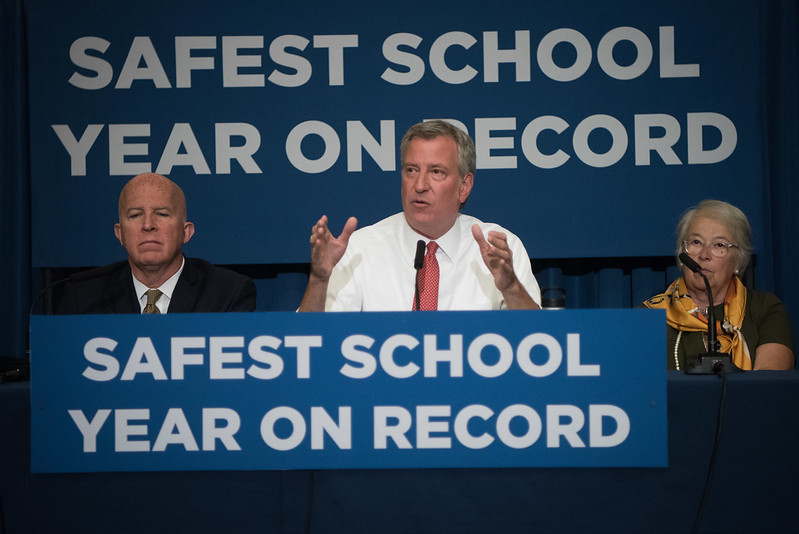
(photo: Michael Appleton/Mayoral Photography Office)
Mayor de Blasio faced a short-answer, timed test: whether and when to close New York City's public schools. It was not an easy question. But his delay in answering and failure to adequately prepare has been costly in lives and learning. We continue to pay the price.
Even where the coronavirus outbreak was less severe and despite ambiguous advice from the CDC, district after district, state after state, had already decided to close their schools. But de Blasio hung on, ignoring dire warnings of community spread from his own Health Department.
At the city Department of Education, controlled by the Mayor and headed by Chancellor Richard Carranza, little preparation for the pandemic seems to have taken place, a fatal error debilitating operational effectiveness and public confidence.
When visiting schools in early March, I questioned principals on information coming from the central Department of Education. One said she had only been sent an extra bottle of Purell. Most were only aware of generic advice on personal hygiene and closure in case of student or staff illness due to COVID-19. But there was no well-known protocol for how families or personnel were to report this, especially in the absence of widespread testing, rapid confirmation, or detailed chains of contact. There was no special guidance on handling coronavirus-related student and faculty absenteeism and other looming administrative issues. Experienced principals with deep connection to their school communities and district liaisons felt ready to report exposures. Less adept leaders were in the dark.
There was no evidence that a distance learning order was just days away. Left unasked were critical questions of device availability for teachers and students, home bandwidth, and curriculum. Needs of home insecure, disabled, and English-as-a-new-language students and their families were ignored at the highest levels despite vigorous hand-waving by their advocates inside and outside the Department of Education.
Finally, after the Mayor precipitously announced on a Sunday night that schools would be closed the next day, he and the Chancellor endangered tens of thousands of teachers and administrators by ordering them into close contact the following week to revamp their classes for mass distance learning. Forgotten in the melee that followed were privacy concerns with the widely-adopted Zoom video platform that was easily hacked and shared student information with third party vendors in violation of the federal Family Educational Rights and Privacy Act (FERPA).
Now we're in for the long-haul, if the Mayor and Governor can get their acts together to agree on closing schools through June and instituting distance learning opportunities at least through the summer.
The Chancellor is given to repeating that "We're building the plane while we fly it." Would that ever be the case, the plane would crash. So it is with a school system carrying over a million kids, attended to by more than that number of parents and other care-givers.
It's time to land that plane, give the administration, educators, students, and their adult protectors time to re-engineer jerry-rigged instructional and administrative policies that have left us -- let's face it -- without a functional public education system for over a month. We don't have attendance information. We’re just starting to learn how many teachers, principals, and other front-line school staff have taken sick or died. Promotion policies, tenure decisions, acceptable and accessible online platforms, and a thousand other critical decisions have yet to be made.
If we have gained any wisdom from this month of havoc, let's use a hiatus to make public education more equal and available as the current pandemic rages, with expected resurgence this fall and beyond. I propose two weeks: one for the DOE to re-engineer and a second for professional development (not in person, of course). Let's not let de Blasio's original sin of delayed preparation or Carranza's self-congratulatory stiff-upper-lip bromides keep us from addressing the long-term educational challenges ahead.
***
David C. Bloomfield is Professor of Education Leadership, Law and Policy at Brooklyn College and The CUNY Graduate Center. On Twitter @BloomfieldDavid.
***
Have an op-ed idea or submission for Gotham Gazette? Email This email address is being protected from spambots. You need JavaScript enabled to view it.
Where Governor Cuomo is Turning a Blind Eye to Coronavirus Spread and Must Take Life-Saving Action Now
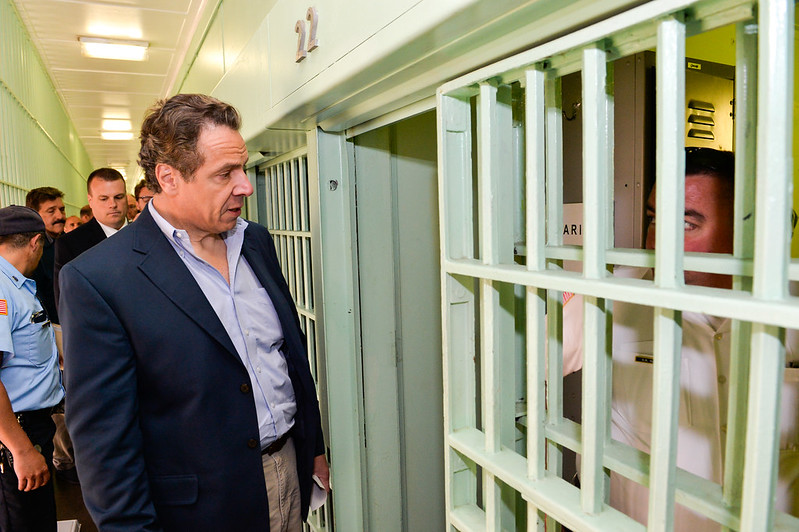
Gov. Cuomo tours a prison (photo: Governor's Office)
At the time of this writing, more than 287 detainees in New York City jails and 441 Department of Correction staff members have tested positive for the new coronavirus, COVID-19. Each of these men and women have friends and family members who wake up every morning, desperately hoping not to receive that dreaded call they know is increasingly possible. And there are thousands more families with loved ones in state prisons who carry that same fear.
The news gets more dire each day. This past week, Michael Tyson, a 53-year-old man, became the first incarcerated person at Rikers Island to die from COVID-19. Just a few days before that, Juan Mosquero died in the infirmary at Sing Sing Correctional Facility—the prison up the river in Ossining. They’re the first tragic coronavirus-related deaths in our state’s jails and prisons, but the data tells us that they won’t be the last.
We know the perilous situation facing thousands of New Yorkers. As two formerly incarcerated individuals, this is personal.
Make no mistake: the standard condition inside correctional facilities is never conducive to health and wellbeing. Prisons and jails are unhealthy environments for all people—whether they work on staff or live there—and amidst a viral pandemic, correctional facilities represent a humanitarian crisis. You can’t perform proper “social distancing” and pandemic personal care in these facilities, where soap and cleaning supplies are rationed, and sanitizer and alcohol products are contraband.
When we were in prison, it was not uncommon to have three or four people held in a small cell, which often included toilet facilities. Meals and recreation were available only in crowded groups.
Which is why, in light of the current situation, it is critically urgent that Governor Cuomo release a comprehensive plan for humanely and properly reducing prison populations across New York. Because while he has taken some key initial steps, he has resisted calls to comprehensively address the looming full-blown crisis in New York’s jails and prisons.
While lowering the populations of New York’s expansive system of locally-operated jails requires buy-in from local governments across the state, the Governor has the sole authority to drastically reduce the state’s prison population today. The Governor could release elderly people, those with chronic conditions, and women who are pregnant and have immune deficiencies. He could introduce a moratorium on incarceration for technical violations of parole and grant early parole to people who are within 180 days of completing their sentences.
These aren’t radical steps. They’re sensible ones. They should have been taken weeks ago; they should be done today.
Other states, including more conservative ones like Ohio and Kentucky, under Republican and Democratic chief executives alike, are taking significant actions to reduce their prison populations. Governors in our neighboring states of New Jersey and Pennsylvania have swiftly implemented solutions to address mass incarceration by removing elderly and ill detainees and those who pose no threat to public safety from facilities into expanded home detention in response to the virus. And for good reason: across America, older adults make up a larger share of state prisons than people 18-24, and there are 150,000 incarcerated people above 55 years old. In San Francisco, the jail population has gone from 1,238 to 766 since the crisis began, and crime rates have plunged.
Astonishingly, Governor Cuomo said more than a week ago that he has no plans to reduce the prison population, almost trying to say it wasn’t possible, even as he sounds repeated alarms for New Yorkers to keep their distance from each other and while a stack of clemency applications for qualified individuals sits on his desk. The Governor can, with the stroke of a pen, choose to release anyone in state custody. He can choose the safety and wellbeing of people in prisons, including corrections officers, and people in the larger community by flattening the curve behind the wall. He can act.
In this global health crisis, we must not condemn people in prison to death through inaction. Hundreds of public health officials and judges have signed letters urging for immediate releases to stem the shocking rise in infections in jails and prisons. We proudly join them to demand that our families, friends, and community members be released, and we stand ready to support people with community services once they are home.
There is still time for Governor Cuomo to flatten the curve behind the wall. As the coronavirus spreads, we can no longer keep it out of our correctional facilities, but we can still take immediate steps to prevent the deaths of thousands of people detained in our jails and prisons, as well as thousands who go to work in them and their family members. And we have the opportunity to emerge from this crisis a more equitable and safe New York.
***
Khalil A. Cumberbatch and Topeka K. Sam are formerly incarcerated New Yorkers who lead New Yorkers United for Justice. On Twitter @KhaCumberbatch & @TopekaKSam & @NYforJustice.
***
Have an op-ed idea or submission for Gotham Gazette? Email This email address is being protected from spambots. You need JavaScript enabled to view it.
Upstate Summer Camps for City Kids: Start Planning Now
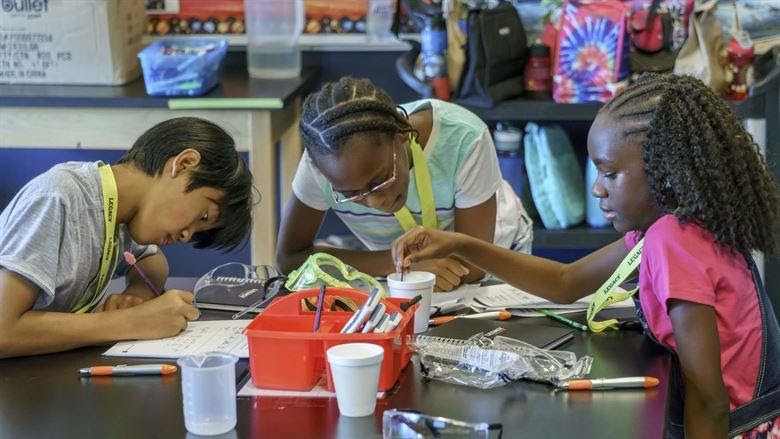
Students enjoying enrichment activities at a Fresh Air Fund Camp (photo: Fresh Air Fund)
The crisis in New York City apartments and neighborhoods grows by the day. Social distance saves lives, but the effects of long-term isolation on families and children will be felt for years unless creative action is taken now.
New York State needs to plan and develop a system of large sleep-away summer camps upstate for city kids who are otherwise facing many months of life in overcrowded apartments. As the temperature rises, and school reopening is delayed, so will family frustration. Shuttered playgrounds and Mayor de Blasio’s massive cuts to the summer youth employment program will only worsen the situation come the summer months.
Where could such extensive summer camps be developed? The upstate campuses of State University of New York (SUNY) and private colleges that have shifted to online learning through the summer can be rapidly developed into such camps. The closure of colleges has left empty dorms (with space for many thousands of kids), classrooms, cafeterias, gyms, and quadrangles that could be refashioned in the coming weeks, for a June 1 start date, as enrichment camps for K-12 students.
Such a plan for campuses, of course, assumes that they will not be needed for medical use thanks to social distancing. So far, thankfully, Governor Cuomo’s successful PAUSE program has forestalled the transformation of campuses into hospitals. We should, therefore, find creative uses for such amazing facilities in a time of social crisis. If the Javits Center can become a hospital, then college campuses can become summer camps.
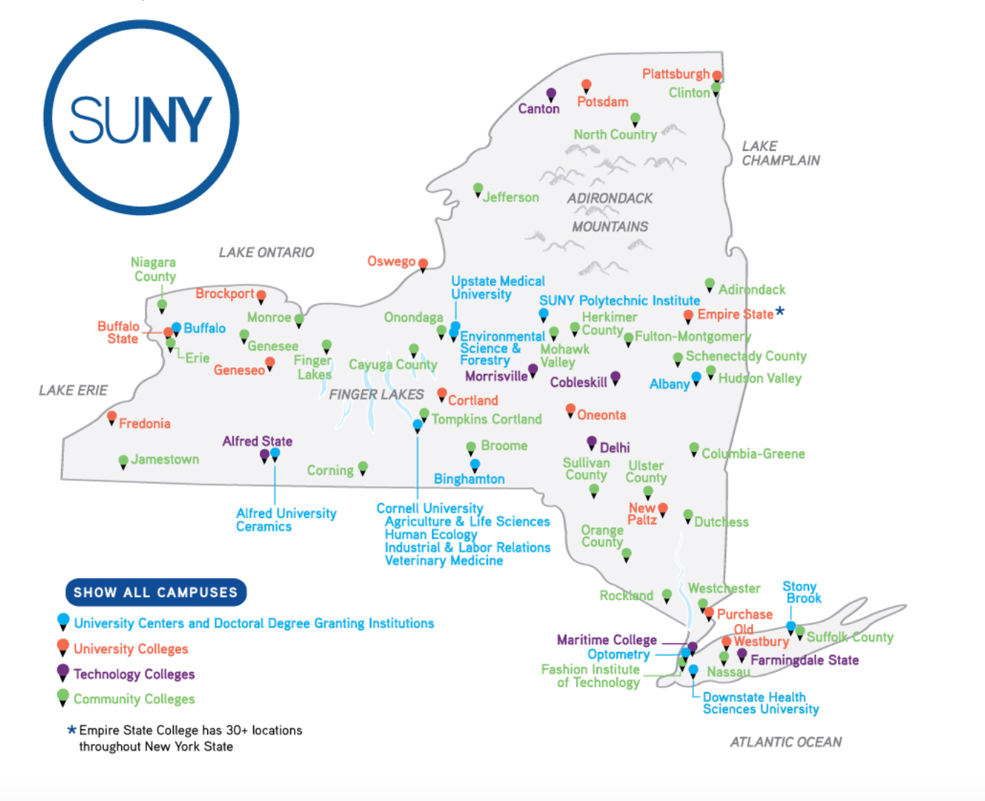 (The scale of the SUNY system, and the large number of residential dorms, offers opportunities for extensive summer camp programs. Private campuses could also be utilized.)
(The scale of the SUNY system, and the large number of residential dorms, offers opportunities for extensive summer camp programs. Private campuses could also be utilized.)
Why send the students to camp? All kids need regular sociability with children their own age for mental health; X-Box, group chats, and Netflix are not going to sustain healthy child development. Campuses also have lots of fields, athletic facilities, and natural surroundings that can inspire students and help them stay fit. Campuses also have plentiful opportunities for educational enrichment. The remarkable facilities on many campuses, such as museums, instructional science labs, computer labs, libraries, and more could help make learning fun for many students. The success of the Fresh Air Fund camps can be a model for program quality.
Who would attend summer camps? Participation in the program, to be sponsored by New York State, would be free and based on voluntary parental permission. Many parents will eagerly embrace such a summer opportunity for their children. In particular, city parents with essential and dangerous jobs desperately need quality child care so that they can continue to run the trains, hospitals, sanitation, and other services the city needs.
Why sleep-away? Students who attend programs in the city and live at home can bring disease back to their apartments and vulnerable older relatives. This is one reason the mayor has cut funding for youth summer employment. At summer camp, however, asymptomatic children would not pose a risk to their parents or grandparents, especially those living in close quarters. Sleep-away camp is a way to practice social distancing while children get enrichment. Time away from families may also help reduce stress in households.
Who would staff the schools? Camp counselors will be college-age students or recent graduates. This demographic has a low viral risk factor and could work and live with children safely. Upstate counties can benefit when their young local residents get jobs in the summer as camp counselors, food service workers, nurses, custodial staff, and program administrators. Community non-profits, with extensive experience in youth programming, could run the camps. Specialty summer camps in arts or sports currently offered on upstate campuses could also be subsidized to scale up for city kids. The key to making this work is social distance. Staff and teachers must be required to live on campus away from their families and nearby towns to minimize the risk of disease.
Given the massive unemployment numbers, such an opportunity is likely to attract well-educated counselors and talented program administrators. It goes without saying that all employees in such a program, as with any youth program, must be carefully vetted. Think of this as an updated version of the successful Civilian Conservation Corp that rebuilt our parks during the Great Depression while reducing unemployment among the young.
What about the threat of disease to upstate communities, teachers, and individuals? These threats could be limited through restrictions of the children and young staff to the campuses. At traditional sleep-away camps everyone lives on campus, including the nurse, and it works. SUNY campuses are ideal because so many are on large and isolated forest and field parcels. Other private campuses are often isolated as well from the main residential areas of town or are located in areas that are primarily rural.
We all hope that a rapid medical solution to the new coronavirus can be found, but there are medium-term steps that can be taken to improve children’s physical and mental health, provide them enrichment, relieve families, and offer other benefits. New York State has invested billions in developing a magnificent system of university campuses. We should be looking at creative options for making best use of these resources during the crisis. The planning needs to start now.
***
Nicholas Dagen Bloom is Professor of Urban Policy and Planning at Hunter College and author of How States Shaped Postwar America: State Government and Urban Policy (Chicago, 2019) among other works.
***
Have an op-ed idea or submission for Gotham Gazette? Email This email address is being protected from spambots. You need JavaScript enabled to view it.




